Research Project: Customer Behavior and Marketing at Sainsbury PLC
VerifiedAdded on 2020/06/06
|11
|3253
|44
Project
AI Summary
This research project investigates the significant influence of customer behavior on the marketing operations of Sainsbury PLC. The study begins by defining customer behavior and outlining its key components, including pre-purchase activities, purchasing decisions, and post-purchase evaluations. It then explores the various factors that affect customer behavior, such as psychological, personal, social, and cultural influences. The project aims to evaluate how understanding these behaviors can enhance marketing strategies and promotional activities. The research employs a qualitative approach, using an exploratory research design and inductive research methods. Data collection involves surveys with marketing managers to gather primary data, which is then analyzed using thematic data analysis. The project's literature review covers the concepts of customer behavior, marketing, and their interrelationships, providing a comprehensive framework for understanding how consumer insights can be effectively integrated into marketing strategies to improve business outcomes. This project is designed to provide valuable insights into the relationship between customer behavior and marketing effectiveness within a real-world business context.

RESEARCH
PROJECT
PROJECT
Paraphrase This Document
Need a fresh take? Get an instant paraphrase of this document with our AI Paraphraser
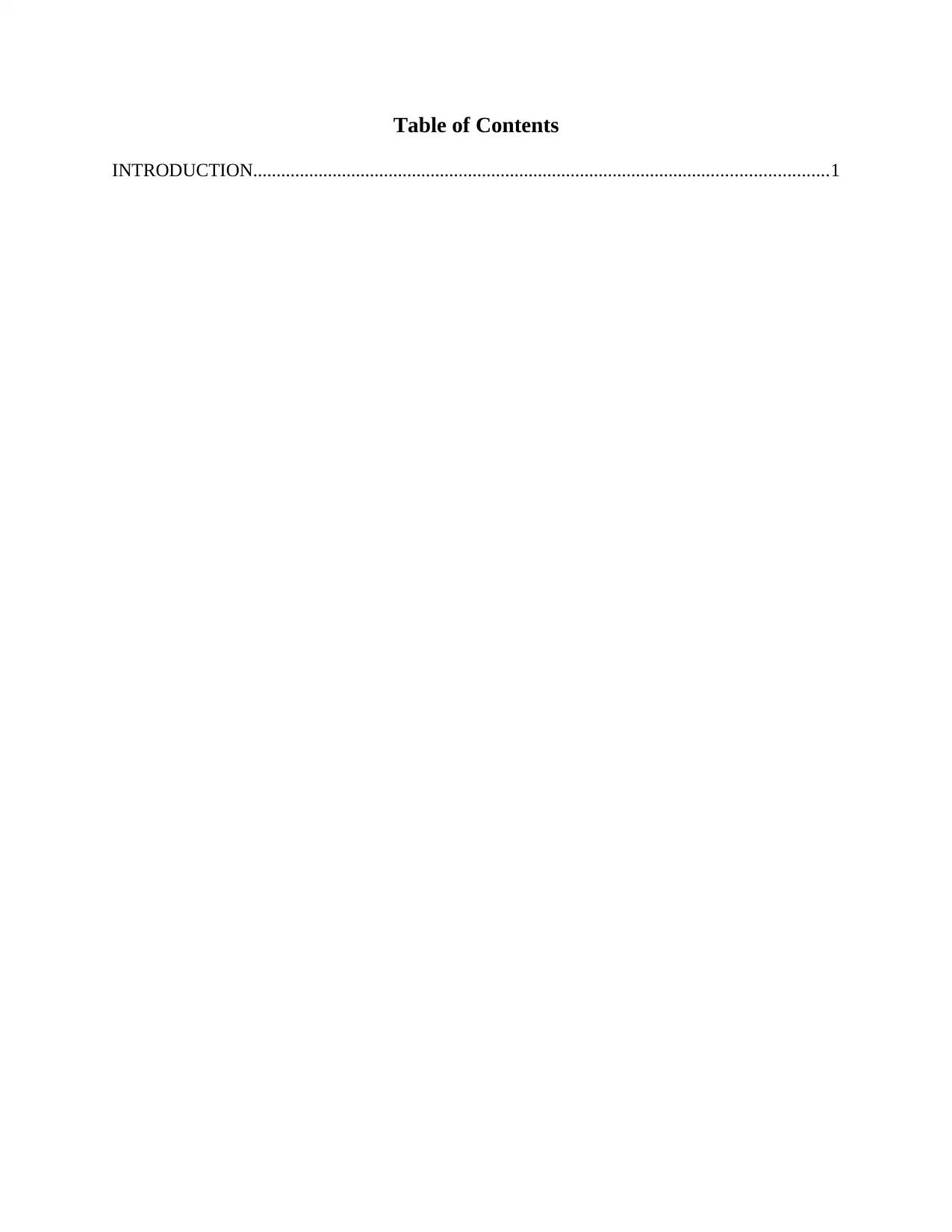
Table of Contents
INTRODUCTION...........................................................................................................................1
INTRODUCTION...........................................................................................................................1
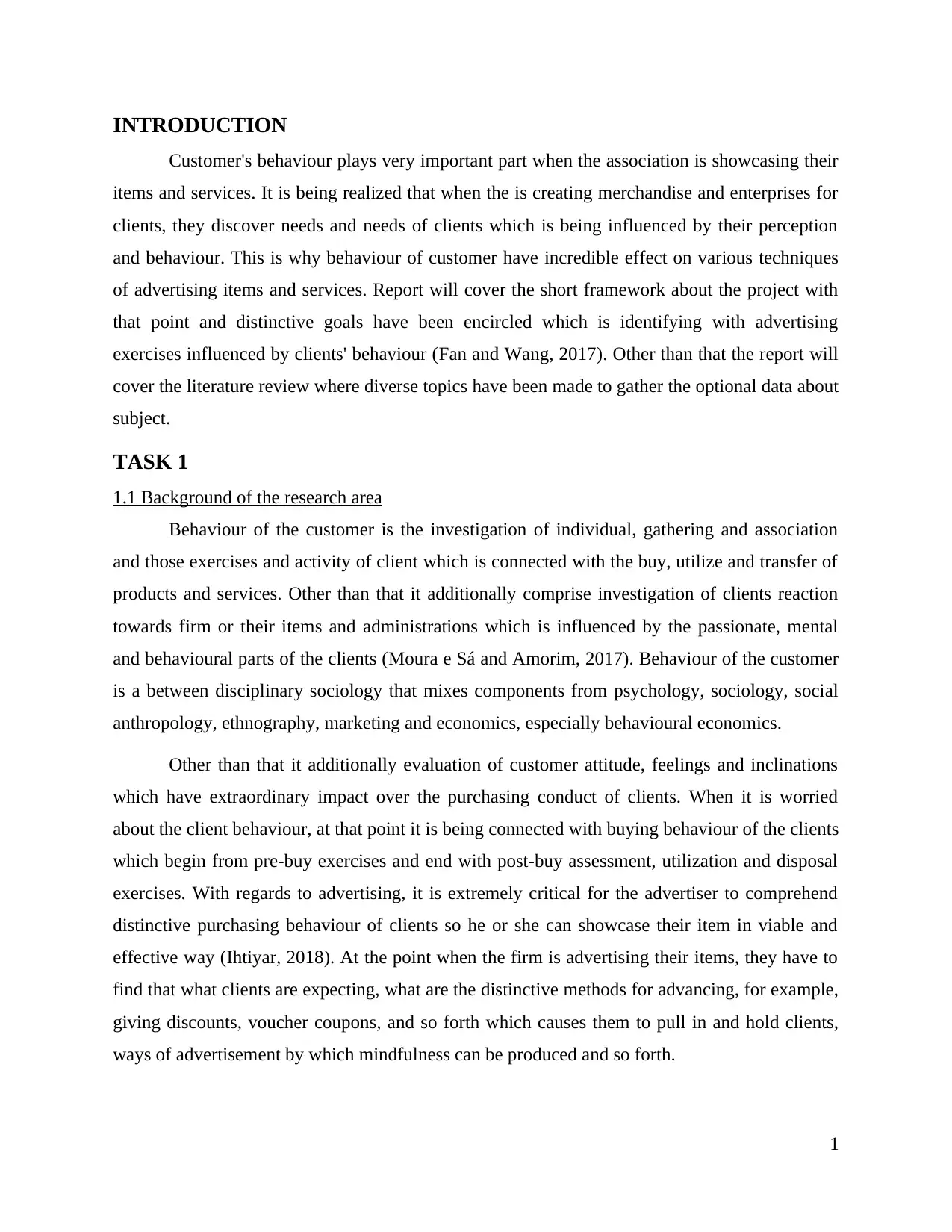
INTRODUCTION
Customer's behaviour plays very important part when the association is showcasing their
items and services. It is being realized that when the is creating merchandise and enterprises for
clients, they discover needs and needs of clients which is being influenced by their perception
and behaviour. This is why behaviour of customer have incredible effect on various techniques
of advertising items and services. Report will cover the short framework about the project with
that point and distinctive goals have been encircled which is identifying with advertising
exercises influenced by clients' behaviour (Fan and Wang, 2017). Other than that the report will
cover the literature review where diverse topics have been made to gather the optional data about
subject.
TASK 1
1.1 Background of the research area
Behaviour of the customer is the investigation of individual, gathering and association
and those exercises and activity of client which is connected with the buy, utilize and transfer of
products and services. Other than that it additionally comprise investigation of clients reaction
towards firm or their items and administrations which is influenced by the passionate, mental
and behavioural parts of the clients (Moura e Sá and Amorim, 2017). Behaviour of the customer
is a between disciplinary sociology that mixes components from psychology, sociology, social
anthropology, ethnography, marketing and economics, especially behavioural economics.
Other than that it additionally evaluation of customer attitude, feelings and inclinations
which have extraordinary impact over the purchasing conduct of clients. When it is worried
about the client behaviour, at that point it is being connected with buying behaviour of the clients
which begin from pre-buy exercises and end with post-buy assessment, utilization and disposal
exercises. With regards to advertising, it is extremely critical for the advertiser to comprehend
distinctive purchasing behaviour of clients so he or she can showcase their item in viable and
effective way (Ihtiyar, 2018). At the point when the firm is advertising their items, they have to
find that what clients are expecting, what are the distinctive methods for advancing, for example,
giving discounts, voucher coupons, and so forth which causes them to pull in and hold clients,
ways of advertisement by which mindfulness can be produced and so forth.
1
Customer's behaviour plays very important part when the association is showcasing their
items and services. It is being realized that when the is creating merchandise and enterprises for
clients, they discover needs and needs of clients which is being influenced by their perception
and behaviour. This is why behaviour of customer have incredible effect on various techniques
of advertising items and services. Report will cover the short framework about the project with
that point and distinctive goals have been encircled which is identifying with advertising
exercises influenced by clients' behaviour (Fan and Wang, 2017). Other than that the report will
cover the literature review where diverse topics have been made to gather the optional data about
subject.
TASK 1
1.1 Background of the research area
Behaviour of the customer is the investigation of individual, gathering and association
and those exercises and activity of client which is connected with the buy, utilize and transfer of
products and services. Other than that it additionally comprise investigation of clients reaction
towards firm or their items and administrations which is influenced by the passionate, mental
and behavioural parts of the clients (Moura e Sá and Amorim, 2017). Behaviour of the customer
is a between disciplinary sociology that mixes components from psychology, sociology, social
anthropology, ethnography, marketing and economics, especially behavioural economics.
Other than that it additionally evaluation of customer attitude, feelings and inclinations
which have extraordinary impact over the purchasing conduct of clients. When it is worried
about the client behaviour, at that point it is being connected with buying behaviour of the clients
which begin from pre-buy exercises and end with post-buy assessment, utilization and disposal
exercises. With regards to advertising, it is extremely critical for the advertiser to comprehend
distinctive purchasing behaviour of clients so he or she can showcase their item in viable and
effective way (Ihtiyar, 2018). At the point when the firm is advertising their items, they have to
find that what clients are expecting, what are the distinctive methods for advancing, for example,
giving discounts, voucher coupons, and so forth which causes them to pull in and hold clients,
ways of advertisement by which mindfulness can be produced and so forth.
1
⊘ This is a preview!⊘
Do you want full access?
Subscribe today to unlock all pages.

Trusted by 1+ million students worldwide
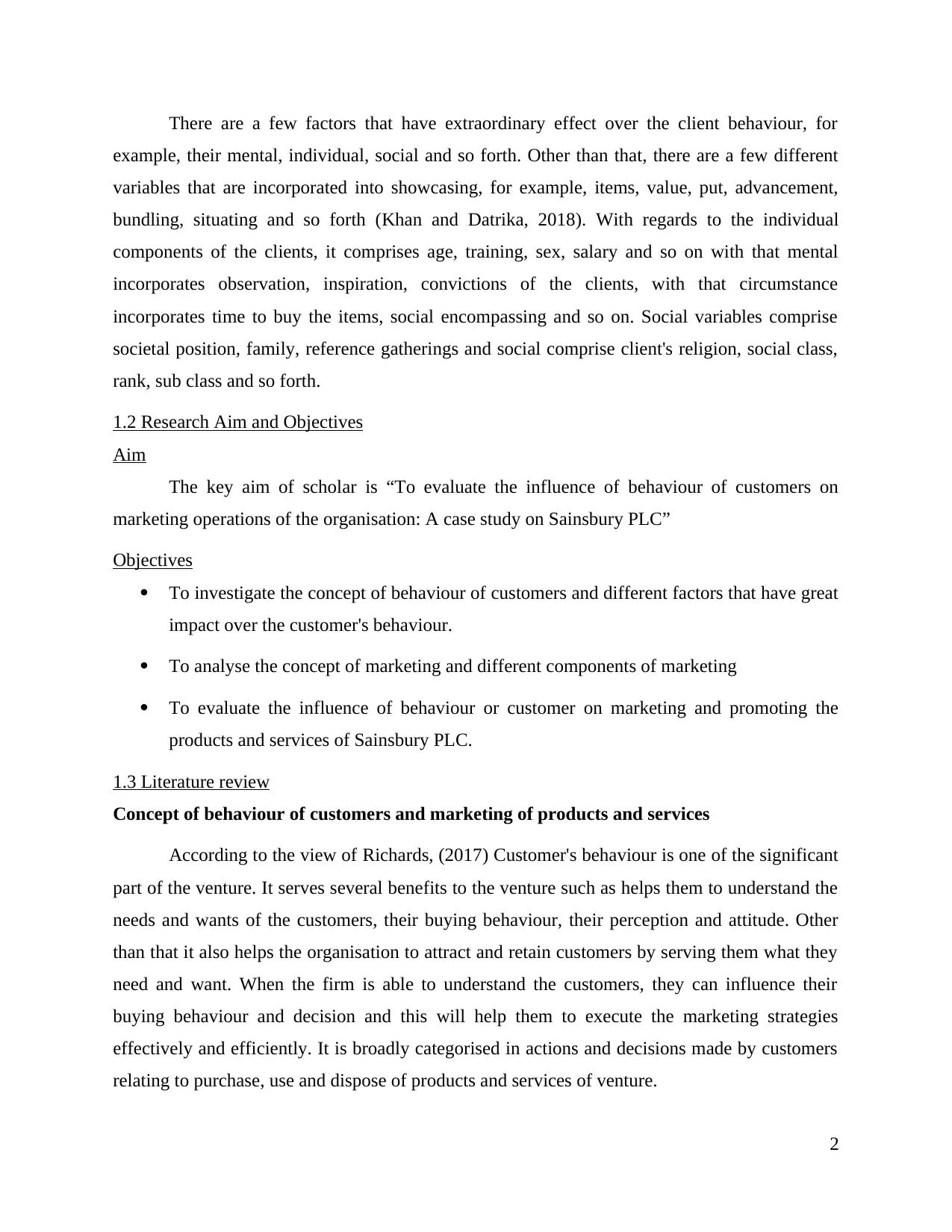
There are a few factors that have extraordinary effect over the client behaviour, for
example, their mental, individual, social and so forth. Other than that, there are a few different
variables that are incorporated into showcasing, for example, items, value, put, advancement,
bundling, situating and so forth (Khan and Datrika, 2018). With regards to the individual
components of the clients, it comprises age, training, sex, salary and so on with that mental
incorporates observation, inspiration, convictions of the clients, with that circumstance
incorporates time to buy the items, social encompassing and so on. Social variables comprise
societal position, family, reference gatherings and social comprise client's religion, social class,
rank, sub class and so forth.
1.2 Research Aim and Objectives
Aim
The key aim of scholar is “To evaluate the influence of behaviour of customers on
marketing operations of the organisation: A case study on Sainsbury PLC”
Objectives
To investigate the concept of behaviour of customers and different factors that have great
impact over the customer's behaviour.
To analyse the concept of marketing and different components of marketing
To evaluate the influence of behaviour or customer on marketing and promoting the
products and services of Sainsbury PLC.
1.3 Literature review
Concept of behaviour of customers and marketing of products and services
According to the view of Richards, (2017) Customer's behaviour is one of the significant
part of the venture. It serves several benefits to the venture such as helps them to understand the
needs and wants of the customers, their buying behaviour, their perception and attitude. Other
than that it also helps the organisation to attract and retain customers by serving them what they
need and want. When the firm is able to understand the customers, they can influence their
buying behaviour and decision and this will help them to execute the marketing strategies
effectively and efficiently. It is broadly categorised in actions and decisions made by customers
relating to purchase, use and dispose of products and services of venture.
2
example, their mental, individual, social and so forth. Other than that, there are a few different
variables that are incorporated into showcasing, for example, items, value, put, advancement,
bundling, situating and so forth (Khan and Datrika, 2018). With regards to the individual
components of the clients, it comprises age, training, sex, salary and so on with that mental
incorporates observation, inspiration, convictions of the clients, with that circumstance
incorporates time to buy the items, social encompassing and so on. Social variables comprise
societal position, family, reference gatherings and social comprise client's religion, social class,
rank, sub class and so forth.
1.2 Research Aim and Objectives
Aim
The key aim of scholar is “To evaluate the influence of behaviour of customers on
marketing operations of the organisation: A case study on Sainsbury PLC”
Objectives
To investigate the concept of behaviour of customers and different factors that have great
impact over the customer's behaviour.
To analyse the concept of marketing and different components of marketing
To evaluate the influence of behaviour or customer on marketing and promoting the
products and services of Sainsbury PLC.
1.3 Literature review
Concept of behaviour of customers and marketing of products and services
According to the view of Richards, (2017) Customer's behaviour is one of the significant
part of the venture. It serves several benefits to the venture such as helps them to understand the
needs and wants of the customers, their buying behaviour, their perception and attitude. Other
than that it also helps the organisation to attract and retain customers by serving them what they
need and want. When the firm is able to understand the customers, they can influence their
buying behaviour and decision and this will help them to execute the marketing strategies
effectively and efficiently. It is broadly categorised in actions and decisions made by customers
relating to purchase, use and dispose of products and services of venture.
2
Paraphrase This Document
Need a fresh take? Get an instant paraphrase of this document with our AI Paraphraser
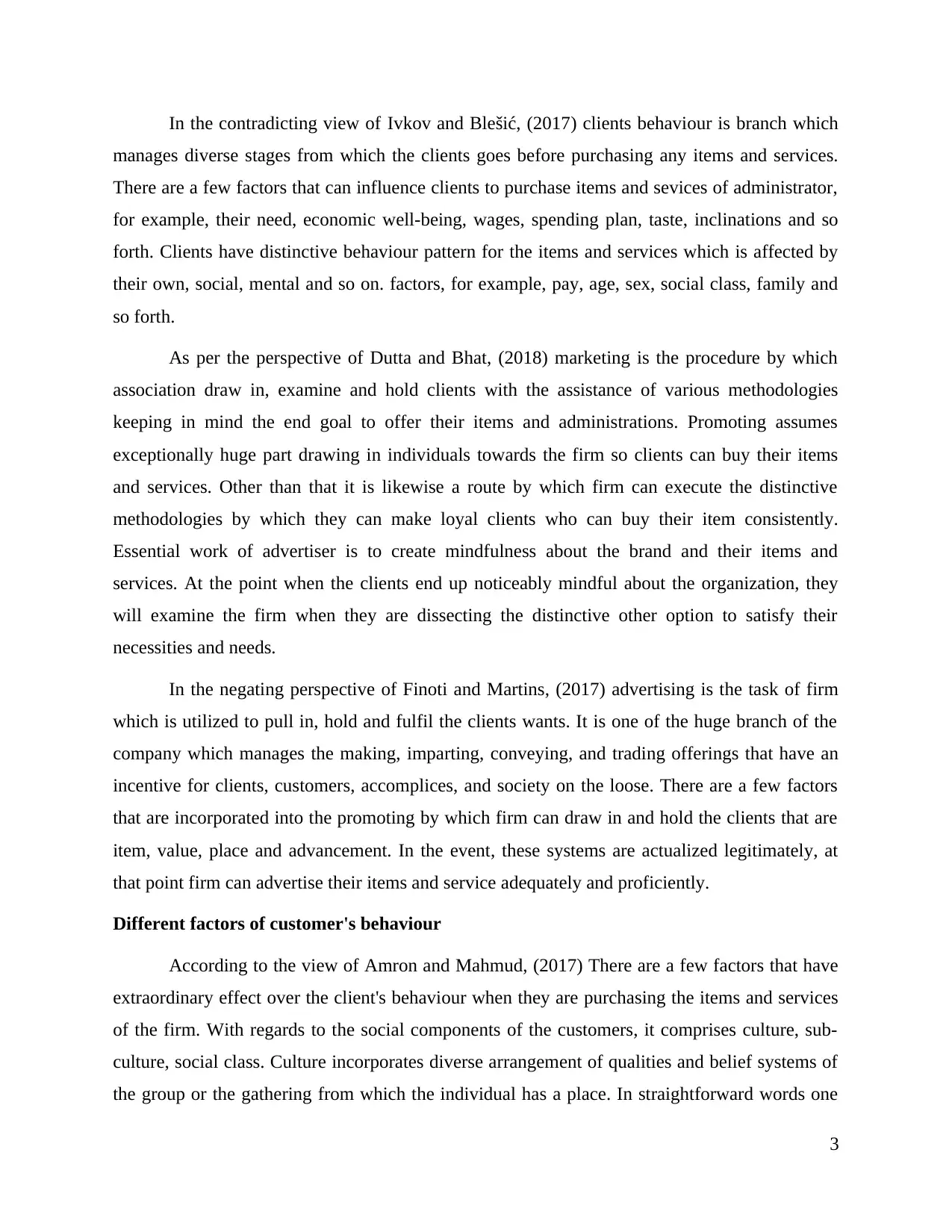
In the contradicting view of Ivkov and Blešić, (2017) clients behaviour is branch which
manages diverse stages from which the clients goes before purchasing any items and services.
There are a few factors that can influence clients to purchase items and sevices of administrator,
for example, their need, economic well-being, wages, spending plan, taste, inclinations and so
forth. Clients have distinctive behaviour pattern for the items and services which is affected by
their own, social, mental and so on. factors, for example, pay, age, sex, social class, family and
so forth.
As per the perspective of Dutta and Bhat, (2018) marketing is the procedure by which
association draw in, examine and hold clients with the assistance of various methodologies
keeping in mind the end goal to offer their items and administrations. Promoting assumes
exceptionally huge part drawing in individuals towards the firm so clients can buy their items
and services. Other than that it is likewise a route by which firm can execute the distinctive
methodologies by which they can make loyal clients who can buy their item consistently.
Essential work of advertiser is to create mindfulness about the brand and their items and
services. At the point when the clients end up noticeably mindful about the organization, they
will examine the firm when they are dissecting the distinctive other option to satisfy their
necessities and needs.
In the negating perspective of Finoti and Martins, (2017) advertising is the task of firm
which is utilized to pull in, hold and fulfil the clients wants. It is one of the huge branch of the
company which manages the making, imparting, conveying, and trading offerings that have an
incentive for clients, customers, accomplices, and society on the loose. There are a few factors
that are incorporated into the promoting by which firm can draw in and hold the clients that are
item, value, place and advancement. In the event, these systems are actualized legitimately, at
that point firm can advertise their items and service adequately and proficiently.
Different factors of customer's behaviour
According to the view of Amron and Mahmud, (2017) There are a few factors that have
extraordinary effect over the client's behaviour when they are purchasing the items and services
of the firm. With regards to the social components of the customers, it comprises culture, sub-
culture, social class. Culture incorporates diverse arrangement of qualities and belief systems of
the group or the gathering from which the individual has a place. In straightforward words one
3
manages diverse stages from which the clients goes before purchasing any items and services.
There are a few factors that can influence clients to purchase items and sevices of administrator,
for example, their need, economic well-being, wages, spending plan, taste, inclinations and so
forth. Clients have distinctive behaviour pattern for the items and services which is affected by
their own, social, mental and so on. factors, for example, pay, age, sex, social class, family and
so forth.
As per the perspective of Dutta and Bhat, (2018) marketing is the procedure by which
association draw in, examine and hold clients with the assistance of various methodologies
keeping in mind the end goal to offer their items and administrations. Promoting assumes
exceptionally huge part drawing in individuals towards the firm so clients can buy their items
and services. Other than that it is likewise a route by which firm can execute the distinctive
methodologies by which they can make loyal clients who can buy their item consistently.
Essential work of advertiser is to create mindfulness about the brand and their items and
services. At the point when the clients end up noticeably mindful about the organization, they
will examine the firm when they are dissecting the distinctive other option to satisfy their
necessities and needs.
In the negating perspective of Finoti and Martins, (2017) advertising is the task of firm
which is utilized to pull in, hold and fulfil the clients wants. It is one of the huge branch of the
company which manages the making, imparting, conveying, and trading offerings that have an
incentive for clients, customers, accomplices, and society on the loose. There are a few factors
that are incorporated into the promoting by which firm can draw in and hold the clients that are
item, value, place and advancement. In the event, these systems are actualized legitimately, at
that point firm can advertise their items and service adequately and proficiently.
Different factors of customer's behaviour
According to the view of Amron and Mahmud, (2017) There are a few factors that have
extraordinary effect over the client's behaviour when they are purchasing the items and services
of the firm. With regards to the social components of the customers, it comprises culture, sub-
culture, social class. Culture incorporates diverse arrangement of qualities and belief systems of
the group or the gathering from which the individual has a place. In straightforward words one
3
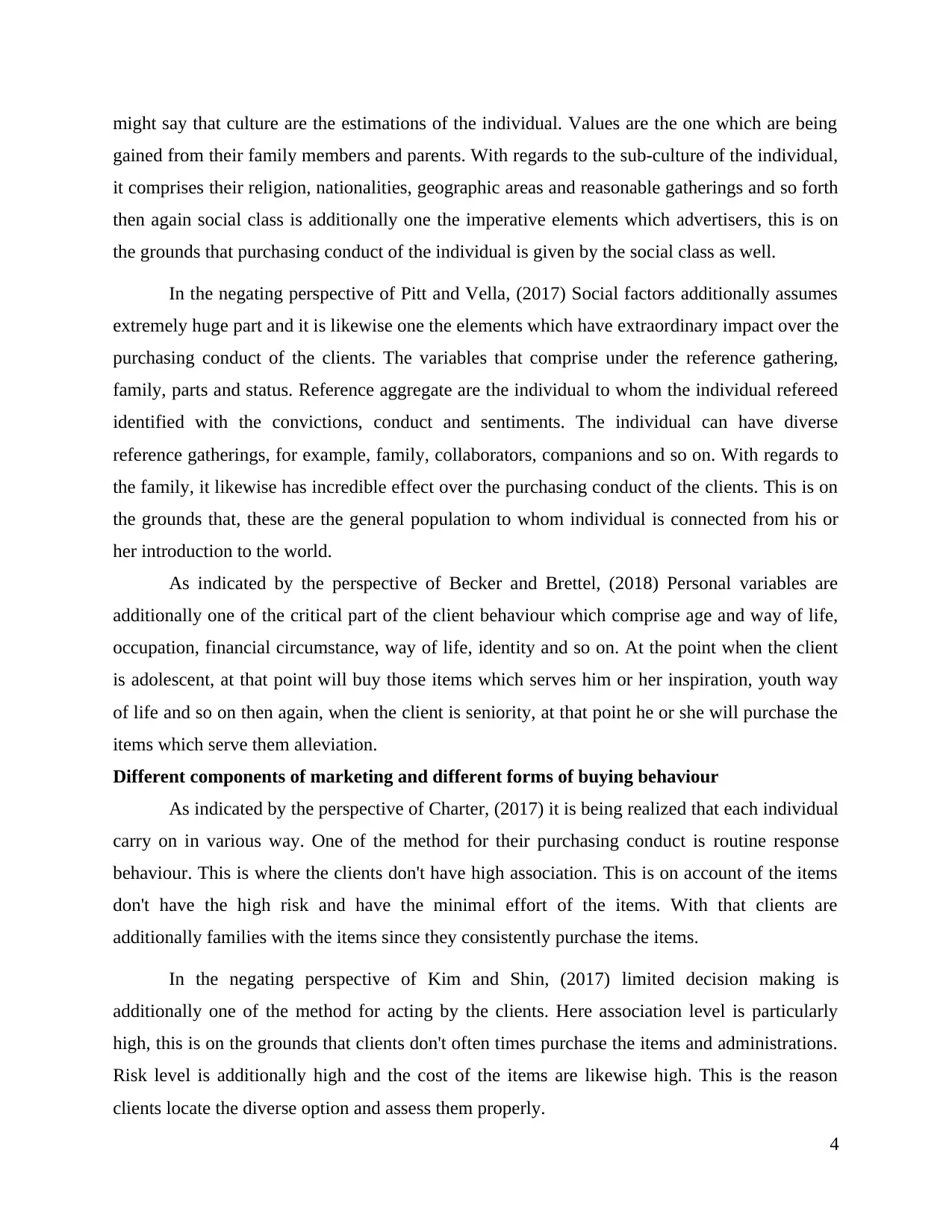
might say that culture are the estimations of the individual. Values are the one which are being
gained from their family members and parents. With regards to the sub-culture of the individual,
it comprises their religion, nationalities, geographic areas and reasonable gatherings and so forth
then again social class is additionally one the imperative elements which advertisers, this is on
the grounds that purchasing conduct of the individual is given by the social class as well.
In the negating perspective of Pitt and Vella, (2017) Social factors additionally assumes
extremely huge part and it is likewise one the elements which have extraordinary impact over the
purchasing conduct of the clients. The variables that comprise under the reference gathering,
family, parts and status. Reference aggregate are the individual to whom the individual refereed
identified with the convictions, conduct and sentiments. The individual can have diverse
reference gatherings, for example, family, collaborators, companions and so on. With regards to
the family, it likewise has incredible effect over the purchasing conduct of the clients. This is on
the grounds that, these are the general population to whom individual is connected from his or
her introduction to the world.
As indicated by the perspective of Becker and Brettel, (2018) Personal variables are
additionally one of the critical part of the client behaviour which comprise age and way of life,
occupation, financial circumstance, way of life, identity and so on. At the point when the client
is adolescent, at that point will buy those items which serves him or her inspiration, youth way
of life and so on then again, when the client is seniority, at that point he or she will purchase the
items which serve them alleviation.
Different components of marketing and different forms of buying behaviour
As indicated by the perspective of Charter, (2017) it is being realized that each individual
carry on in various way. One of the method for their purchasing conduct is routine response
behaviour. This is where the clients don't have high association. This is on account of the items
don't have the high risk and have the minimal effort of the items. With that clients are
additionally families with the items since they consistently purchase the items.
In the negating perspective of Kim and Shin, (2017) limited decision making is
additionally one of the method for acting by the clients. Here association level is particularly
high, this is on the grounds that clients don't often times purchase the items and administrations.
Risk level is additionally high and the cost of the items are likewise high. This is the reason
clients locate the diverse option and assess them properly.
4
gained from their family members and parents. With regards to the sub-culture of the individual,
it comprises their religion, nationalities, geographic areas and reasonable gatherings and so forth
then again social class is additionally one the imperative elements which advertisers, this is on
the grounds that purchasing conduct of the individual is given by the social class as well.
In the negating perspective of Pitt and Vella, (2017) Social factors additionally assumes
extremely huge part and it is likewise one the elements which have extraordinary impact over the
purchasing conduct of the clients. The variables that comprise under the reference gathering,
family, parts and status. Reference aggregate are the individual to whom the individual refereed
identified with the convictions, conduct and sentiments. The individual can have diverse
reference gatherings, for example, family, collaborators, companions and so on. With regards to
the family, it likewise has incredible effect over the purchasing conduct of the clients. This is on
the grounds that, these are the general population to whom individual is connected from his or
her introduction to the world.
As indicated by the perspective of Becker and Brettel, (2018) Personal variables are
additionally one of the critical part of the client behaviour which comprise age and way of life,
occupation, financial circumstance, way of life, identity and so on. At the point when the client
is adolescent, at that point will buy those items which serves him or her inspiration, youth way
of life and so on then again, when the client is seniority, at that point he or she will purchase the
items which serve them alleviation.
Different components of marketing and different forms of buying behaviour
As indicated by the perspective of Charter, (2017) it is being realized that each individual
carry on in various way. One of the method for their purchasing conduct is routine response
behaviour. This is where the clients don't have high association. This is on account of the items
don't have the high risk and have the minimal effort of the items. With that clients are
additionally families with the items since they consistently purchase the items.
In the negating perspective of Kim and Shin, (2017) limited decision making is
additionally one of the method for acting by the clients. Here association level is particularly
high, this is on the grounds that clients don't often times purchase the items and administrations.
Risk level is additionally high and the cost of the items are likewise high. This is the reason
clients locate the diverse option and assess them properly.
4
⊘ This is a preview!⊘
Do you want full access?
Subscribe today to unlock all pages.

Trusted by 1+ million students worldwide
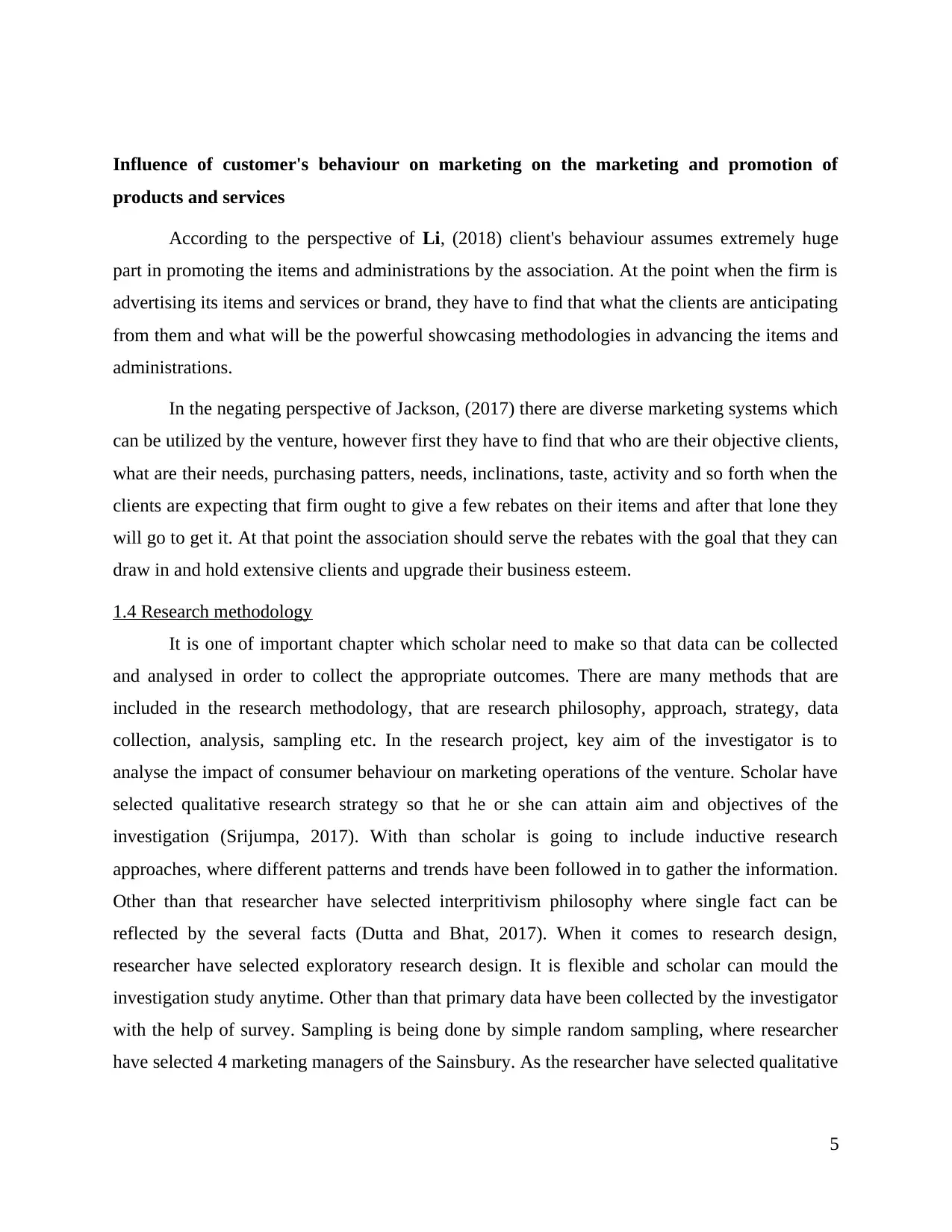
Influence of customer's behaviour on marketing on the marketing and promotion of
products and services
According to the perspective of Li, (2018) client's behaviour assumes extremely huge
part in promoting the items and administrations by the association. At the point when the firm is
advertising its items and services or brand, they have to find that what the clients are anticipating
from them and what will be the powerful showcasing methodologies in advancing the items and
administrations.
In the negating perspective of Jackson, (2017) there are diverse marketing systems which
can be utilized by the venture, however first they have to find that who are their objective clients,
what are their needs, purchasing patters, needs, inclinations, taste, activity and so forth when the
clients are expecting that firm ought to give a few rebates on their items and after that lone they
will go to get it. At that point the association should serve the rebates with the goal that they can
draw in and hold extensive clients and upgrade their business esteem.
1.4 Research methodology
It is one of important chapter which scholar need to make so that data can be collected
and analysed in order to collect the appropriate outcomes. There are many methods that are
included in the research methodology, that are research philosophy, approach, strategy, data
collection, analysis, sampling etc. In the research project, key aim of the investigator is to
analyse the impact of consumer behaviour on marketing operations of the venture. Scholar have
selected qualitative research strategy so that he or she can attain aim and objectives of the
investigation (Srijumpa, 2017). With than scholar is going to include inductive research
approaches, where different patterns and trends have been followed in to gather the information.
Other than that researcher have selected interpritivism philosophy where single fact can be
reflected by the several facts (Dutta and Bhat, 2017). When it comes to research design,
researcher have selected exploratory research design. It is flexible and scholar can mould the
investigation study anytime. Other than that primary data have been collected by the investigator
with the help of survey. Sampling is being done by simple random sampling, where researcher
have selected 4 marketing managers of the Sainsbury. As the researcher have selected qualitative
5
products and services
According to the perspective of Li, (2018) client's behaviour assumes extremely huge
part in promoting the items and administrations by the association. At the point when the firm is
advertising its items and services or brand, they have to find that what the clients are anticipating
from them and what will be the powerful showcasing methodologies in advancing the items and
administrations.
In the negating perspective of Jackson, (2017) there are diverse marketing systems which
can be utilized by the venture, however first they have to find that who are their objective clients,
what are their needs, purchasing patters, needs, inclinations, taste, activity and so forth when the
clients are expecting that firm ought to give a few rebates on their items and after that lone they
will go to get it. At that point the association should serve the rebates with the goal that they can
draw in and hold extensive clients and upgrade their business esteem.
1.4 Research methodology
It is one of important chapter which scholar need to make so that data can be collected
and analysed in order to collect the appropriate outcomes. There are many methods that are
included in the research methodology, that are research philosophy, approach, strategy, data
collection, analysis, sampling etc. In the research project, key aim of the investigator is to
analyse the impact of consumer behaviour on marketing operations of the venture. Scholar have
selected qualitative research strategy so that he or she can attain aim and objectives of the
investigation (Srijumpa, 2017). With than scholar is going to include inductive research
approaches, where different patterns and trends have been followed in to gather the information.
Other than that researcher have selected interpritivism philosophy where single fact can be
reflected by the several facts (Dutta and Bhat, 2017). When it comes to research design,
researcher have selected exploratory research design. It is flexible and scholar can mould the
investigation study anytime. Other than that primary data have been collected by the investigator
with the help of survey. Sampling is being done by simple random sampling, where researcher
have selected 4 marketing managers of the Sainsbury. As the researcher have selected qualitative
5
Paraphrase This Document
Need a fresh take? Get an instant paraphrase of this document with our AI Paraphraser
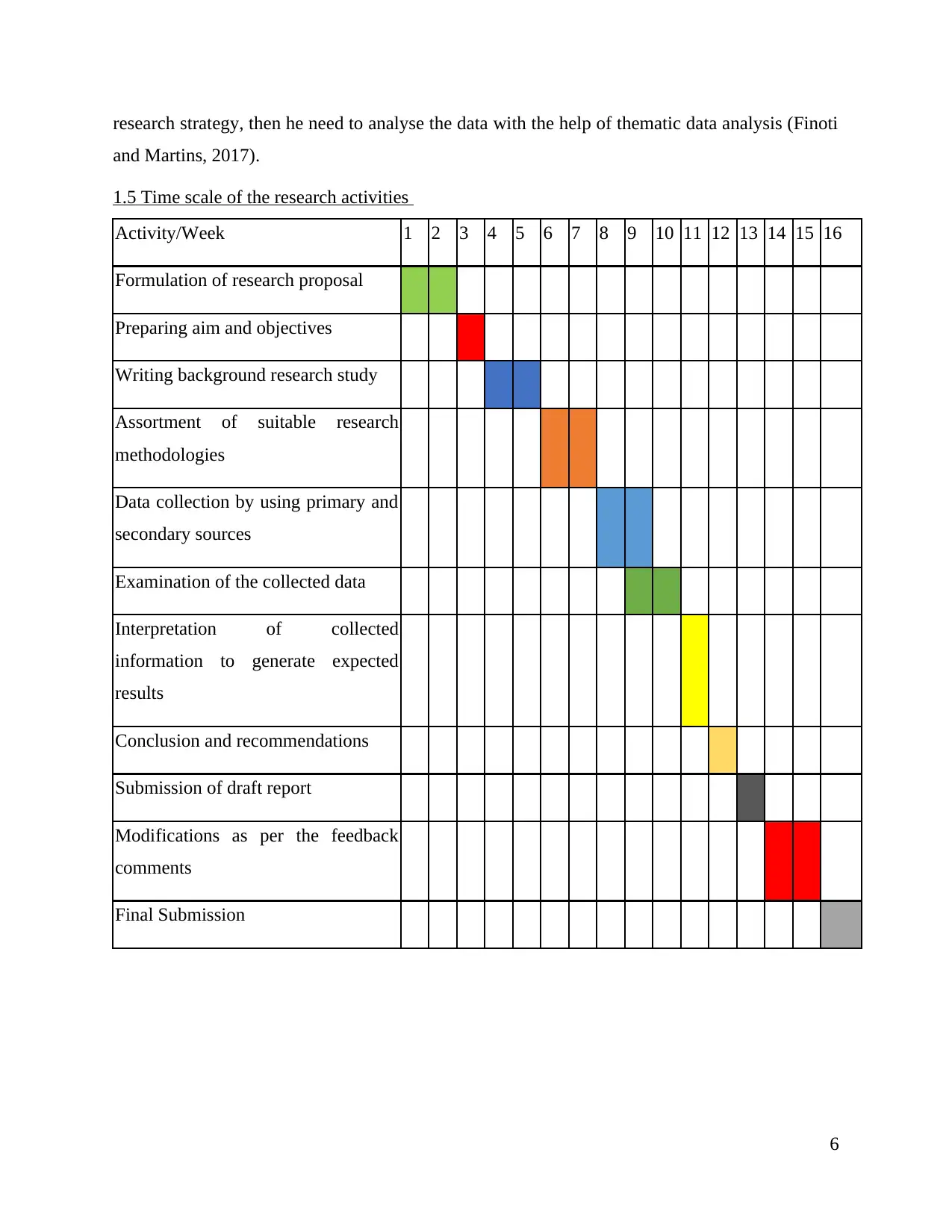
research strategy, then he need to analyse the data with the help of thematic data analysis (Finoti
and Martins, 2017).
1.5 Time scale of the research activities
Activity/Week 1 2 3 4 5 6 7 8 9 10 11 12 13 14 15 16
Formulation of research proposal
Preparing aim and objectives
Writing background research study
Assortment of suitable research
methodologies
Data collection by using primary and
secondary sources
Examination of the collected data
Interpretation of collected
information to generate expected
results
Conclusion and recommendations
Submission of draft report
Modifications as per the feedback
comments
Final Submission
6
and Martins, 2017).
1.5 Time scale of the research activities
Activity/Week 1 2 3 4 5 6 7 8 9 10 11 12 13 14 15 16
Formulation of research proposal
Preparing aim and objectives
Writing background research study
Assortment of suitable research
methodologies
Data collection by using primary and
secondary sources
Examination of the collected data
Interpretation of collected
information to generate expected
results
Conclusion and recommendations
Submission of draft report
Modifications as per the feedback
comments
Final Submission
6
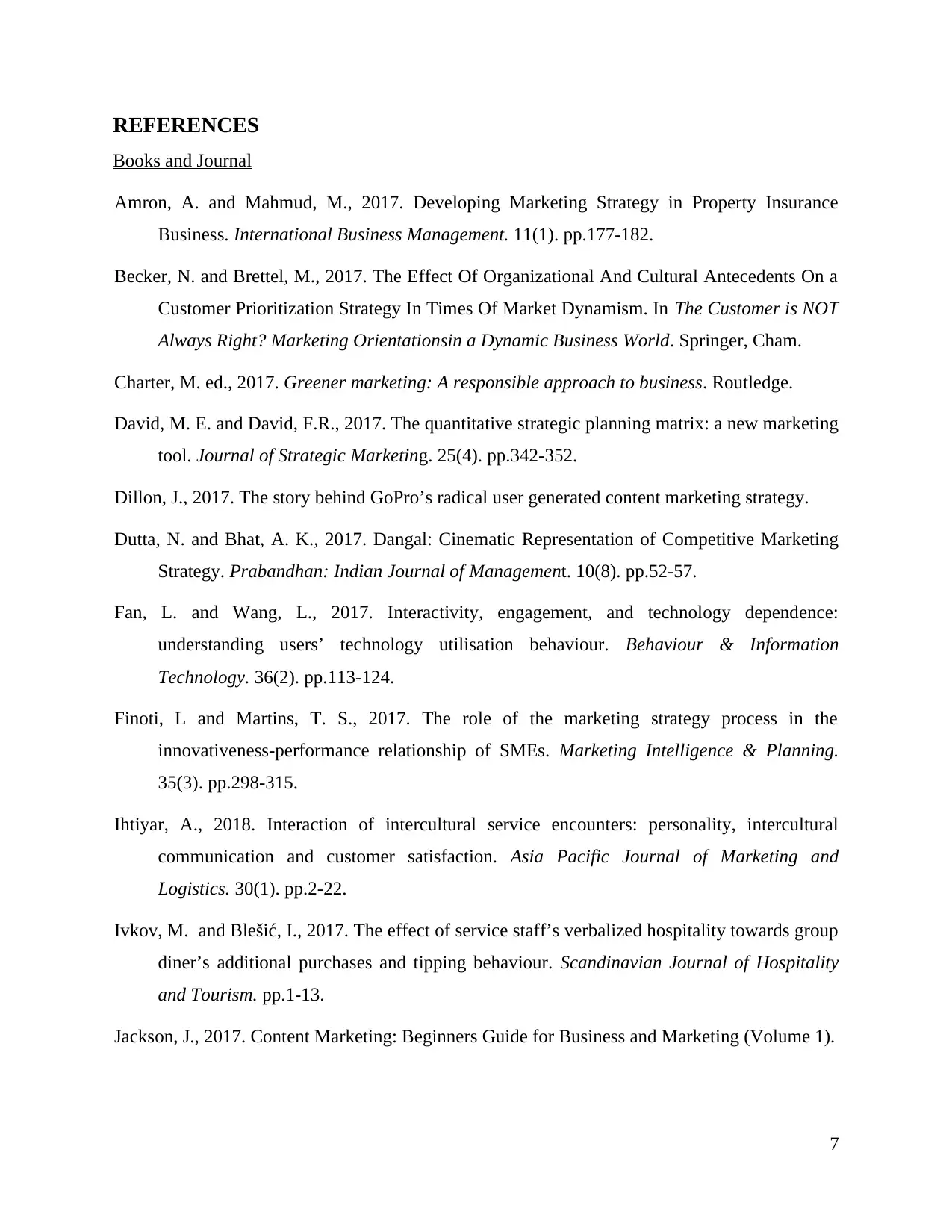
REFERENCES
Books and Journal
Amron, A. and Mahmud, M., 2017. Developing Marketing Strategy in Property Insurance
Business. International Business Management. 11(1). pp.177-182.
Becker, N. and Brettel, M., 2017. The Effect Of Organizational And Cultural Antecedents On a
Customer Prioritization Strategy In Times Of Market Dynamism. In The Customer is NOT
Always Right? Marketing Orientationsin a Dynamic Business World. Springer, Cham.
Charter, M. ed., 2017. Greener marketing: A responsible approach to business. Routledge.
David, M. E. and David, F.R., 2017. The quantitative strategic planning matrix: a new marketing
tool. Journal of Strategic Marketing. 25(4). pp.342-352.
Dillon, J., 2017. The story behind GoPro’s radical user generated content marketing strategy.
Dutta, N. and Bhat, A. K., 2017. Dangal: Cinematic Representation of Competitive Marketing
Strategy. Prabandhan: Indian Journal of Management. 10(8). pp.52-57.
Fan, L. and Wang, L., 2017. Interactivity, engagement, and technology dependence:
understanding users’ technology utilisation behaviour. Behaviour & Information
Technology. 36(2). pp.113-124.
Finoti, L and Martins, T. S., 2017. The role of the marketing strategy process in the
innovativeness-performance relationship of SMEs. Marketing Intelligence & Planning.
35(3). pp.298-315.
Ihtiyar, A., 2018. Interaction of intercultural service encounters: personality, intercultural
communication and customer satisfaction. Asia Pacific Journal of Marketing and
Logistics. 30(1). pp.2-22.
Ivkov, M. and Blešić, I., 2017. The effect of service staff’s verbalized hospitality towards group
diner’s additional purchases and tipping behaviour. Scandinavian Journal of Hospitality
and Tourism. pp.1-13.
Jackson, J., 2017. Content Marketing: Beginners Guide for Business and Marketing (Volume 1).
7
Books and Journal
Amron, A. and Mahmud, M., 2017. Developing Marketing Strategy in Property Insurance
Business. International Business Management. 11(1). pp.177-182.
Becker, N. and Brettel, M., 2017. The Effect Of Organizational And Cultural Antecedents On a
Customer Prioritization Strategy In Times Of Market Dynamism. In The Customer is NOT
Always Right? Marketing Orientationsin a Dynamic Business World. Springer, Cham.
Charter, M. ed., 2017. Greener marketing: A responsible approach to business. Routledge.
David, M. E. and David, F.R., 2017. The quantitative strategic planning matrix: a new marketing
tool. Journal of Strategic Marketing. 25(4). pp.342-352.
Dillon, J., 2017. The story behind GoPro’s radical user generated content marketing strategy.
Dutta, N. and Bhat, A. K., 2017. Dangal: Cinematic Representation of Competitive Marketing
Strategy. Prabandhan: Indian Journal of Management. 10(8). pp.52-57.
Fan, L. and Wang, L., 2017. Interactivity, engagement, and technology dependence:
understanding users’ technology utilisation behaviour. Behaviour & Information
Technology. 36(2). pp.113-124.
Finoti, L and Martins, T. S., 2017. The role of the marketing strategy process in the
innovativeness-performance relationship of SMEs. Marketing Intelligence & Planning.
35(3). pp.298-315.
Ihtiyar, A., 2018. Interaction of intercultural service encounters: personality, intercultural
communication and customer satisfaction. Asia Pacific Journal of Marketing and
Logistics. 30(1). pp.2-22.
Ivkov, M. and Blešić, I., 2017. The effect of service staff’s verbalized hospitality towards group
diner’s additional purchases and tipping behaviour. Scandinavian Journal of Hospitality
and Tourism. pp.1-13.
Jackson, J., 2017. Content Marketing: Beginners Guide for Business and Marketing (Volume 1).
7
⊘ This is a preview!⊘
Do you want full access?
Subscribe today to unlock all pages.

Trusted by 1+ million students worldwide
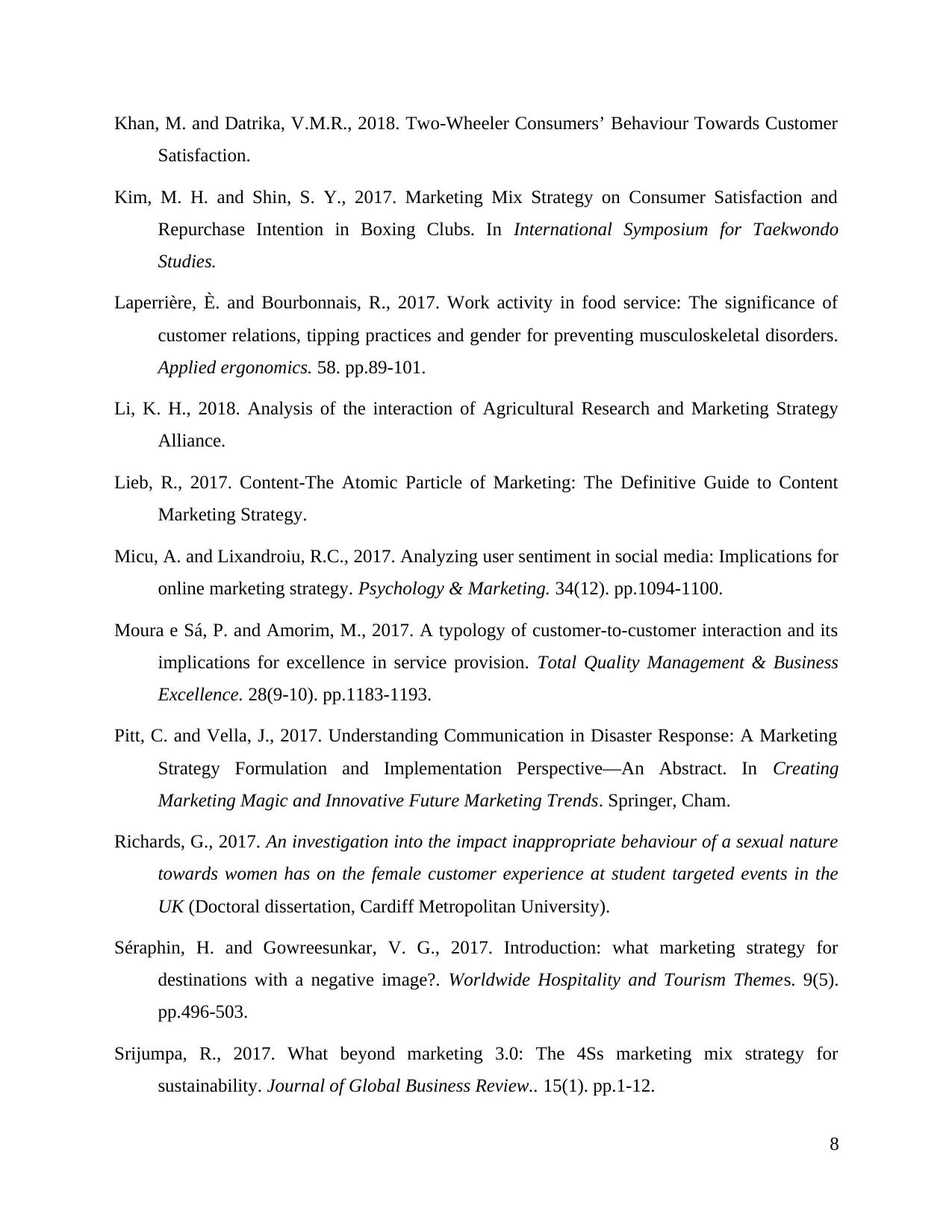
Khan, M. and Datrika, V.M.R., 2018. Two-Wheeler Consumers’ Behaviour Towards Customer
Satisfaction.
Kim, M. H. and Shin, S. Y., 2017. Marketing Mix Strategy on Consumer Satisfaction and
Repurchase Intention in Boxing Clubs. In International Symposium for Taekwondo
Studies.
Laperrière, È. and Bourbonnais, R., 2017. Work activity in food service: The significance of
customer relations, tipping practices and gender for preventing musculoskeletal disorders.
Applied ergonomics. 58. pp.89-101.
Li, K. H., 2018. Analysis of the interaction of Agricultural Research and Marketing Strategy
Alliance.
Lieb, R., 2017. Content-The Atomic Particle of Marketing: The Definitive Guide to Content
Marketing Strategy.
Micu, A. and Lixandroiu, R.C., 2017. Analyzing user sentiment in social media: Implications for
online marketing strategy. Psychology & Marketing. 34(12). pp.1094-1100.
Moura e Sá, P. and Amorim, M., 2017. A typology of customer-to-customer interaction and its
implications for excellence in service provision. Total Quality Management & Business
Excellence. 28(9-10). pp.1183-1193.
Pitt, C. and Vella, J., 2017. Understanding Communication in Disaster Response: A Marketing
Strategy Formulation and Implementation Perspective—An Abstract. In Creating
Marketing Magic and Innovative Future Marketing Trends. Springer, Cham.
Richards, G., 2017. An investigation into the impact inappropriate behaviour of a sexual nature
towards women has on the female customer experience at student targeted events in the
UK (Doctoral dissertation, Cardiff Metropolitan University).
Séraphin, H. and Gowreesunkar, V. G., 2017. Introduction: what marketing strategy for
destinations with a negative image?. Worldwide Hospitality and Tourism Themes. 9(5).
pp.496-503.
Srijumpa, R., 2017. What beyond marketing 3.0: The 4Ss marketing mix strategy for
sustainability. Journal of Global Business Review.. 15(1). pp.1-12.
8
Satisfaction.
Kim, M. H. and Shin, S. Y., 2017. Marketing Mix Strategy on Consumer Satisfaction and
Repurchase Intention in Boxing Clubs. In International Symposium for Taekwondo
Studies.
Laperrière, È. and Bourbonnais, R., 2017. Work activity in food service: The significance of
customer relations, tipping practices and gender for preventing musculoskeletal disorders.
Applied ergonomics. 58. pp.89-101.
Li, K. H., 2018. Analysis of the interaction of Agricultural Research and Marketing Strategy
Alliance.
Lieb, R., 2017. Content-The Atomic Particle of Marketing: The Definitive Guide to Content
Marketing Strategy.
Micu, A. and Lixandroiu, R.C., 2017. Analyzing user sentiment in social media: Implications for
online marketing strategy. Psychology & Marketing. 34(12). pp.1094-1100.
Moura e Sá, P. and Amorim, M., 2017. A typology of customer-to-customer interaction and its
implications for excellence in service provision. Total Quality Management & Business
Excellence. 28(9-10). pp.1183-1193.
Pitt, C. and Vella, J., 2017. Understanding Communication in Disaster Response: A Marketing
Strategy Formulation and Implementation Perspective—An Abstract. In Creating
Marketing Magic and Innovative Future Marketing Trends. Springer, Cham.
Richards, G., 2017. An investigation into the impact inappropriate behaviour of a sexual nature
towards women has on the female customer experience at student targeted events in the
UK (Doctoral dissertation, Cardiff Metropolitan University).
Séraphin, H. and Gowreesunkar, V. G., 2017. Introduction: what marketing strategy for
destinations with a negative image?. Worldwide Hospitality and Tourism Themes. 9(5).
pp.496-503.
Srijumpa, R., 2017. What beyond marketing 3.0: The 4Ss marketing mix strategy for
sustainability. Journal of Global Business Review.. 15(1). pp.1-12.
8
Paraphrase This Document
Need a fresh take? Get an instant paraphrase of this document with our AI Paraphraser
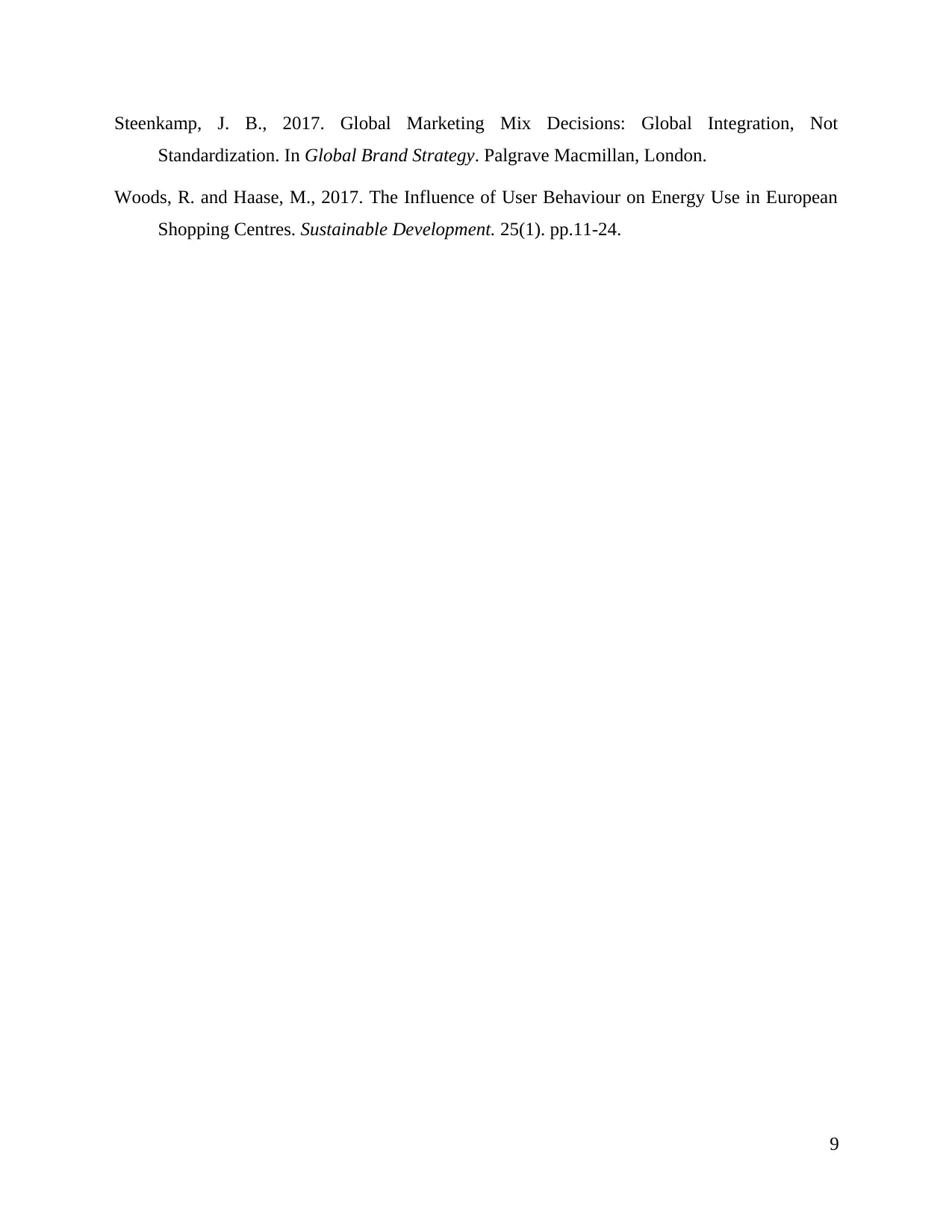
Steenkamp, J. B., 2017. Global Marketing Mix Decisions: Global Integration, Not
Standardization. In Global Brand Strategy. Palgrave Macmillan, London.
Woods, R. and Haase, M., 2017. The Influence of User Behaviour on Energy Use in European
Shopping Centres. Sustainable Development. 25(1). pp.11-24.
9
Standardization. In Global Brand Strategy. Palgrave Macmillan, London.
Woods, R. and Haase, M., 2017. The Influence of User Behaviour on Energy Use in European
Shopping Centres. Sustainable Development. 25(1). pp.11-24.
9
1 out of 11
Related Documents
Your All-in-One AI-Powered Toolkit for Academic Success.
+13062052269
info@desklib.com
Available 24*7 on WhatsApp / Email
![[object Object]](/_next/static/media/star-bottom.7253800d.svg)
Unlock your academic potential
Copyright © 2020–2025 A2Z Services. All Rights Reserved. Developed and managed by ZUCOL.



